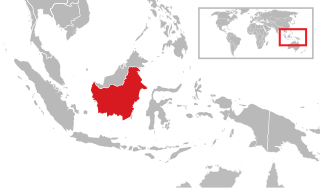
Kalimantan is the Indonesian portion of the island of Borneo. It constitutes 73% of the island's area. The non-Indonesian parts of Borneo are Brunei and East Malaysia. In Indonesia, "Kalimantan" refers to the whole island of Borneo.
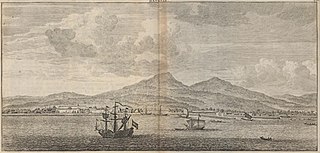
Batavia was the capital of the Dutch East Indies. The area corresponds to present-day Jakarta, Indonesia. Batavia can refer to the city proper or its suburbs and hinterland, the Ommelanden, which included the much-larger area of the Residency of Batavia in the present-day Indonesian provinces of Jakarta, Banten and West Java.

Bengkulu is a province of Indonesia. It is located on the southwest coast of Sumatra. It was formed on 18 November 1968 by separating out the former Bencoolen Residency area from the province of South Sumatra under Law No. 9 of 1967 and was finalized by Government Regulation No. 20 of 1968. Spread over 19,813 km2, it is bordered by the provinces of West Sumatra to the north, Jambi to the northeast, Lampung to the southeast, and South Sumatra to the east, and by the Indian Ocean to the northwest, south, southwest, and west.
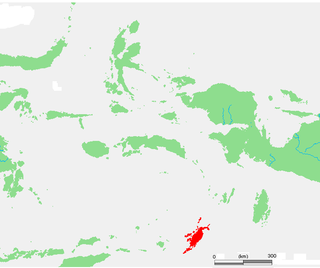
The Tanimbar Islands, also called Timur Laut, are a group of about 65 islands in the Maluku province of Indonesia. The largest and most central of the islands is Yamdena; others include Selaru to the southwest of Yamdena, Larat and Fordata to the northeast, Maru and Molu to the north, and Seira, Wuliaru, Selu, Wotap and Makasar to the west. The Indonesian phrase timur laut means "east of the sea" or "northeast".
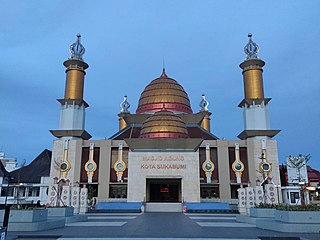
Sukabumi is a landlocked city surrounded by the regency of the same name (enclave) in the southern foothills of Mount Gede, in West Java, Indonesia, about 100 km (62 mi) south of the national capital, Jakarta.

Parepare is a city (kota) in South Sulawesi, Indonesia, located on the southwest coast of Sulawesi, about 155 km (96 mi) north of the provincial capital of Makassar. A port town, it is one of the major population centers of the Bugis people. The city had a population of 129,542 people at the 2010 Census and 151,454 at the 2020 Census.

The Dutch Ethical Policy was the official policy of the colonial government of the Dutch East Indies during the four decades from 1901 until the Japanese occupation of 1942. In 1901, Dutch Queen Wilhelmina announced that the Netherlands accepted an ethical responsibility for the welfare of their colonial subjects. The announcement was a sharp contrast with the former official doctrine that Indonesia was a wingewest and also marked the start of modern development policy. Other colonial powers talked of a civilising mission, which mainly involved spreading their culture to the colonised peoples.
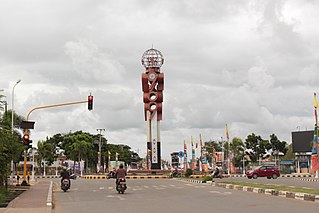
Merauke, also known as the District of Merauke, is a large town and the capital of the South Papua province, Indonesia. It is also the administrative centre of Merauke Regency in South Papua. It is considered the easternmost city in Indonesia. The town was originally called Ermasoe. It is next to the Maro River where the Port of Merauke is located. As of the 2010 census, Merauke had a population of 87,634 which at the 2020 Census had increased to 102,351.

The Indonesian National Awakening is a term for the period in the first half of the 20th century, during which people from many parts of the archipelago of Indonesia first began to develop a national consciousness as "Indonesians".

Bosscha Observatory is the oldest modern observatory in Indonesia, and one of the oldest in Asia. The observatory is located in Lembang, West Java, approximately 15 kilometers (9.3 mi) north of Bandung. It is situated on a hilly six hectares of land and is 1,310 m (4,300 ft) above mean sea level plateau. The IAU observatory code for Bosscha is 299.

Company rule in the Dutch East Indies began when the Dutch East India Company appointed the first governor-general of the Dutch East Indies in 1610, and ended in 1800 when the bankrupt company was dissolved and its possessions were nationalized as the Dutch East Indies. By then it exerted territorial control over much of the archipelago, most notably on Java.

The Dutch East Indies, also known as the Netherlands East Indies, was a Dutch colony consisting of what is now Indonesia. It was formed from the nationalised trading posts of the Dutch East India Company, which came under the administration of the Dutch government in 1800.

Arab Indonesians or Hadharem, informally known as Jama'ah, and until the 20th century known as Codjas or Kodjas, are Indonesian citizens of mixed Arab – mainly Hadhrami – and Indonesian descent. The group also includes those of Arab descent from other Middle Eastern Arabic speaking nations. Restricted under Dutch East Indies law until 1919, the community elites later gained economic power through real estate investment and trading. Currently found mainly in Java, especially West Java and South Sumatra, they are almost all Muslims.

The Indo people are Eurasian people living in or connected with Indonesia. In its narrowest sense, the term refers to people in the former Dutch East Indies who held European legal status but were of mixed Dutch and indigenous Indonesian descent as well as their descendants today.

The Javanese diaspora is the demographic group of descendants of ethnic Javanese who emigrated from the Indonesian island of Java to other parts of the world. The Javanese diaspora includes a significant population in Suriname, with over 13% of the country's population being of Javanese ancestry. Other major enclaves are found in Australia, French Guiana, Malaysia, the Netherlands, New Caledonia, Singapore, South Africa, and Sri Lanka.

Koedoes Residency was an administrative division (Residency) of Central Java province of the Dutch East Indies with its capital at Kudus, which existed between 1928 and 1931. It was significantly larger than the present-day Kudus Regency, as it also contained Demak Regency and Jepara Regency.

Buitenzorg Residency was an administrative division (Residency) of the Dutch East Indies located in western Java which existed from 1817 to 1867 and from 1925 to 1942. Its seat was at Buitenzorg which was also the seat of the colonial government of the Indies after 1905.
Censuses in Indonesia are censuses of Indonesia's population, agriculture, and economy conducted by Statistics Indonesia. The first census after independence was held in 1961.

The 1961 Indonesian census was the first census of Indonesia as a sovereign state. With a total population of 97,018,829, Indonesia was the world's fifth-most populous country at the time. The census covered all territories in the country, but no enumeration was done in Indonesian-claimed Western New Guinea because it was under Dutch occupation. Instead, an estimated population for the region was included in the final census numbers.
Censuses in the Dutch East Indies were censuses in the Dutch East Indies colony of the Netherlands. The last census was conducted in 1930.


















